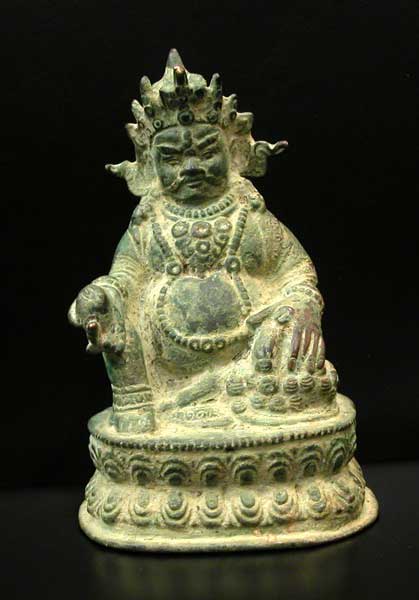Bronze Figurine of a Seated Kubera, 16th Century CE - 18th Century CE
Bronze
4 x 6
LO.756
Further images
In Nepalese art, Kubera, the god of wealth and food, is sometimes shown riding on a snow-lion, or in Vaishravan yab-yum position with his consort. Among statues of Kubera seated...
In Nepalese art, Kubera, the god of wealth and food, is sometimes shown riding on a snow-lion, or in Vaishravan yab-yum position with his consort. Among statues of Kubera seated in royal ease, this finely cast bronze statue stands unique, as it incorporates elements of medieval Eastern Indian with the Newari tradition of the Katmandu Buddhist art tradition and design motifs.
Nepal is a country at the crossroads between India and Tibet and thus the forms of worship found there contain elements of Indian Vedic and Tantric Hinduism as well as Tibetan Buddhism and Tibetan Bon (animism). In the style typical of Tibetan and Nepalese tantric iconography, they are all wearing elaborate pointed crowns and displaying their open third eyes.
Following such tradition, this small figurine of Kubera, featuring an ornate head-dress, fully endorsed with conch shells (a symbol of prosperous voyage), is portrayed seated in lalitasana on a lotus throne, his right leg bent upwards, his right hand holding a conch shell, and his left resting on what could be a Nakula Mongoose (which believed to be the receptacle of all riches).
The commanding presence of this statue of Kubera befits his role as the emanation of Vaisravana Dharmarpala, the Lord of Wealth and Guardian Deity of the North. He is the most important deity among the eight generals of Vaisravana. The statue is sealed with a copper base engraved with a double vajra, an indication of a ritual blessing known as "rab gnas", a consecrated process which a high ranking Lama invites the deity to enter into the completed image, and the statue is believed to contain the actual presence of the deity, the dharmakaya, or Truth Body of the Buddha.
Nepal is a country at the crossroads between India and Tibet and thus the forms of worship found there contain elements of Indian Vedic and Tantric Hinduism as well as Tibetan Buddhism and Tibetan Bon (animism). In the style typical of Tibetan and Nepalese tantric iconography, they are all wearing elaborate pointed crowns and displaying their open third eyes.
Following such tradition, this small figurine of Kubera, featuring an ornate head-dress, fully endorsed with conch shells (a symbol of prosperous voyage), is portrayed seated in lalitasana on a lotus throne, his right leg bent upwards, his right hand holding a conch shell, and his left resting on what could be a Nakula Mongoose (which believed to be the receptacle of all riches).
The commanding presence of this statue of Kubera befits his role as the emanation of Vaisravana Dharmarpala, the Lord of Wealth and Guardian Deity of the North. He is the most important deity among the eight generals of Vaisravana. The statue is sealed with a copper base engraved with a double vajra, an indication of a ritual blessing known as "rab gnas", a consecrated process which a high ranking Lama invites the deity to enter into the completed image, and the statue is believed to contain the actual presence of the deity, the dharmakaya, or Truth Body of the Buddha.





